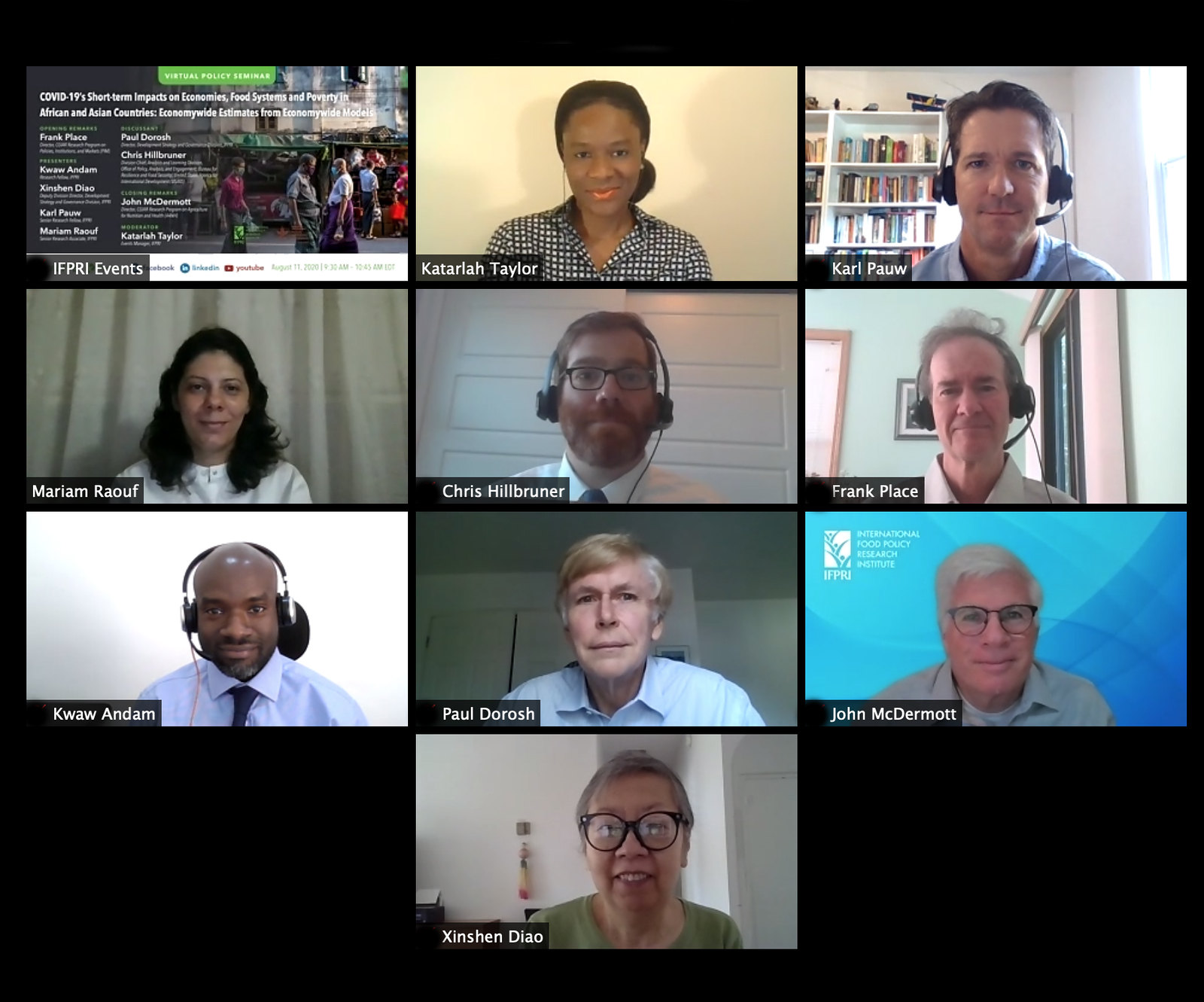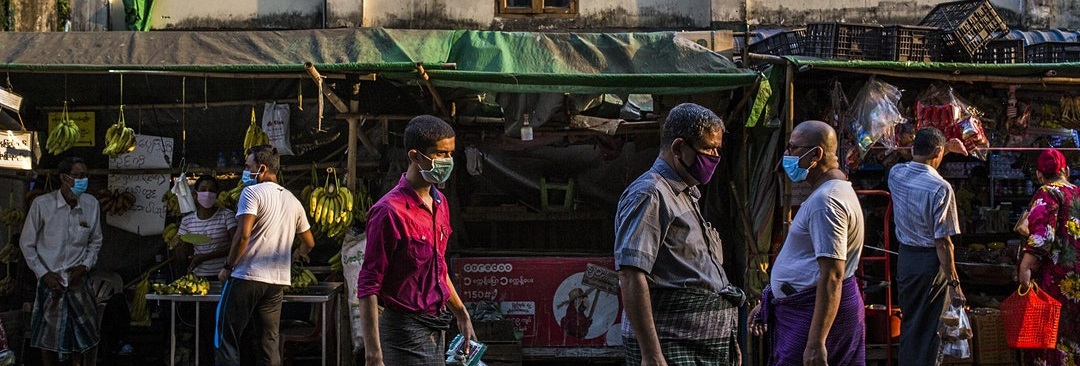Countries around the world have responded to the COVID-19 pandemic by implementing lockdowns and other social distancing measures. Agrifood systems and food supply chains—although generally exempt from restrictions—have nevertheless experienced disruptions and global market instability. An Aug. 11 virtual policy seminar organized by IFPRI and the CGIAR Research Program on Policies, Institutions, and Markets (PIM) explored recent findings of IFPRI-led, PIM-supported work measuring the pandemic’s impacts on economies and food systems in Nigeria, Myanmar, and Sudan.

PIM Director Frank Place opened the seminar noting that as governments are evaluating whether and for how long to continue current pandemic policies or to make adaptations, IFPRI’s expertise in modeling and demand-driven policy support has been in especially high demand.
SAM multiplier modeling approach
Researchers are using the Social Accounting Matrix (SAM) multiplier modeling framework to measure the impacts of COVID-19 on the case-study countries’ economies. The SAM-based models enable identification of direct and indirect effects of both domestic measures and external shocks along and across supply chains, explained Karl Pauw, leader of IFPRI’s Ghana Strategy Support Program. They also cast light on how those shocks affect employment, household incomes, and poverty. The analysis sought to systematically compare impacts across countries’ agrifood systems assuming slower or faster economic recovery rates.
The countries in the study suffered substantial but varying GDP losses during lockdowns (from 13.8% in Sudan to 41.1% in Myanmar) depending on policy design and exposure to global markets, Pauw said. Despite exemptions, impacts on food systems account for approximately one quarter of those losses. While wealthier urban households face larger income losses, poorer rural households face significant shocks and may find it harder to cope. These impacts have already led to large increases in poverty, especially during the second quarter of 2020. As economies start to recover, they may return to pre-crisis poverty levels by the end of the year, but projected growth rates for 2020 are being revised sharply downward.
Nigeria
Nigeria’s GDP dropped 34% during the lockdown period, with most losses in the services and industry sectors, said Kwaw Andam, leader of IFPRI’s Nigeria Strategy Support Program. Closing non-essential wholesale and retail trade caused the largest share of agrifood related GDP losses (over 40%), followed by hotels, restaurants, and bars closures, which contributed an additional 20% loss. While pre-COVID projected 2020 GDP growth was about 2.5%, the revised scenarios range from -6.8% to -11.4% GDP growth path depending on the speed of restrictions easing and economic recovery.
Sudan
While the general GDP losses in Sudan were the smallest (13.8%) among the countries in the case study, the pattern is similar, with biggest contributions from the services and industry sectors, said Mariam Raouf, a senior research associate with IFPRI’s Cairo office. Restrictions imposed on trade and transport account for around one third of the losses. Around 1.4 million people may have temporarily lost jobs. COVID-19 will likely push Sudan’s economy into a recession and significantly increase poverty in 2020. The devastating desert locust crisis ongoing in East Africa aggravates the situation. The IFPRI team estimates the negative growth rate at about -4.8% to -9.8%.
Myanmar
Myanmar’s huge 41% GDP loss occurred during its brief lockdown period of two weeks in April, said Xinshen Diao, deputy director of IFPRI’s Development Strategy and Governance Division. At the sector level, declines in services and industry are much larger than in agriculture, with construction being the most affected (82% decline). The impacts on the agrifood system (AFS) are larger than on agriculture alone: the agricultural GDP fell by 14% while the decline in AFS GDP reached 24%. The closure of manufacturing facilities severely affected agro-processing, agrifood related trade and transport, and food services, causing about 48% of the AFS decline. Two other sources of the loss were significant reductions in export demand and remittances. Despite the dramatic decline in the first part of the year, the short duration of the lockdown means that Myanmar can get back to a modest but positive GDP growth in the third and fourth quarters under the fast recovery scenario.
What's next? Looking beyond 2020
The study has been very helpful in better understanding the pathways through which the pandemic is affecting households and economies, and in designing response strategies, said Chris Hillbruner, chief of the Analysis and Learning Division, Office of Policy, Analysis, and Engagement, USAID Bureau for Resilience and Food Security.
First, he said, the work has been undertaken in close collaboration with national governments. Not only does this improve the quality of modeling inputs, it ensures that the work is connected to the real policy system. Second, the approach unpacks the impacts on the agrifood system and how it was affected despite the lack of formal restrictions. This is especially important to understand given the sector’s potential to drive economic growth and recovery. Third, the analysis points to where and how the COVID-19-related impacts are more pronounced: While infection rates and the size of the income losses have been greater in urban areas, more people in rural areas have been pushed into poverty. Looking beyond 2020, Hillbruner asked, how are the current impacts going to evolve?
Paul Dorosh, director of the IFPRI’s Development Strategy and Governance Division, suggested three areas worth further exploration. First, analyzing how different agricultural subsectors have been affected, and how seasonality and country-specific climate patterns might influence the pandemic’s short- and mid-term economic effects. Second, learning more about potential medium-term effects, including the challenges of larger national debt burdens and investment in the overall economy and the agrifood sector. Third, examining the implications of price changes caused by COVID-19 shocks and mitigation measures.
Lessons learned
In his closing remarks, John McDermott, director of the CGIAR Research Program on Agriculture for Nutrition and Health (A4NH), emphasized three lessons. First, since even severe lockdowns have not been completely successful in preventing viral transmission in many countries, more nuanced and balanced approaches may need to be considered going forward. Second, the harm done to poor and vulnerable people must be addressed. For low-income countries, it will critical to use limited resources smartly to support social safety nets and nutrition and women’s empowerment programs, among others, that are crucial to recovery and future development. Finally, COVID-19 has led to significant job losses, especially in new and emerging sectors such as food services, food distribution, and food processing. Addressing those losses and providing the necessary support to small and medium-sized enterprises is another crucial factor in the recovery phase.
Evgeniya Anisimova is a Senior Communications Specialist with the CGIAR Research Program on Policies, Institutions, and Markets (PIM). This post also appears on the IFPRI website.



